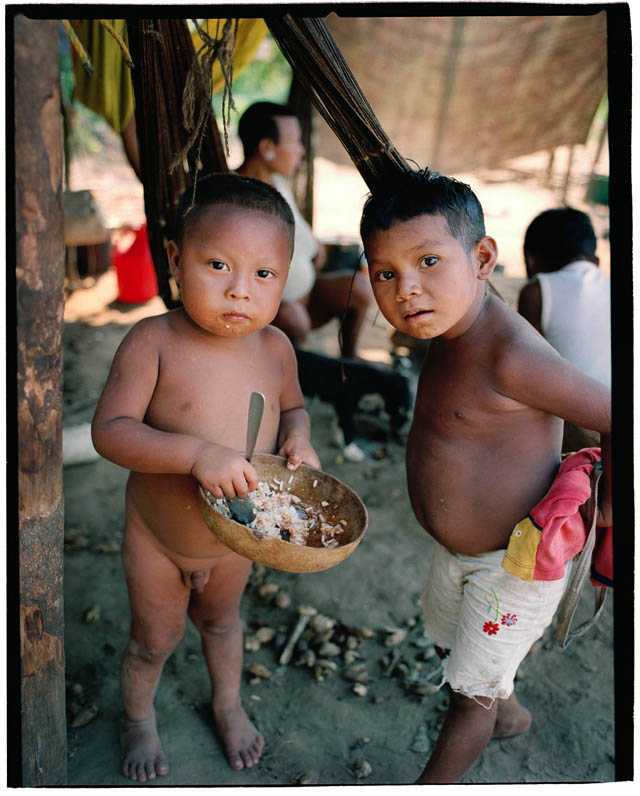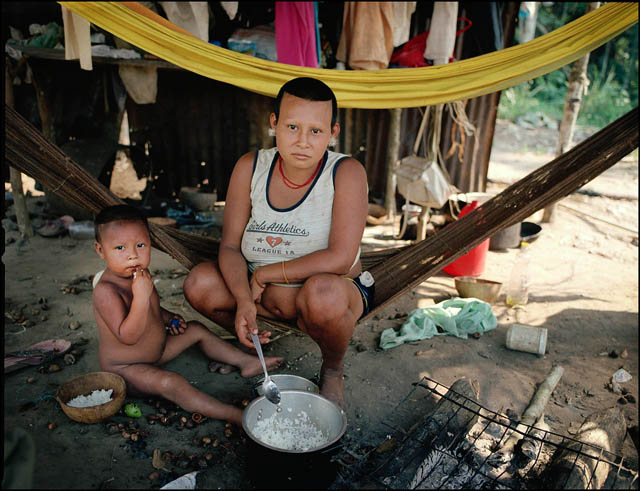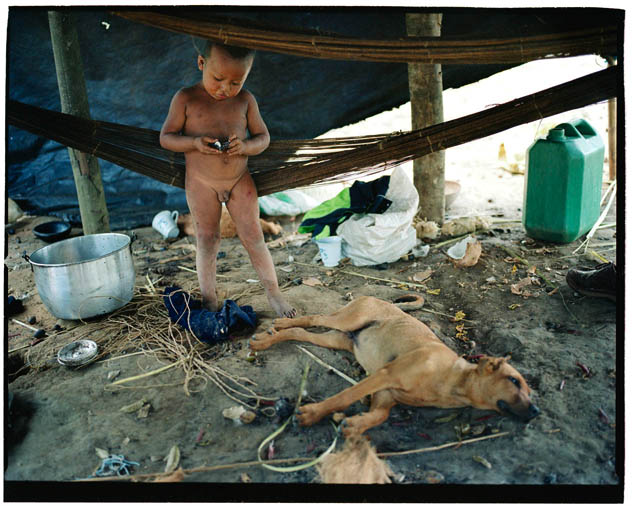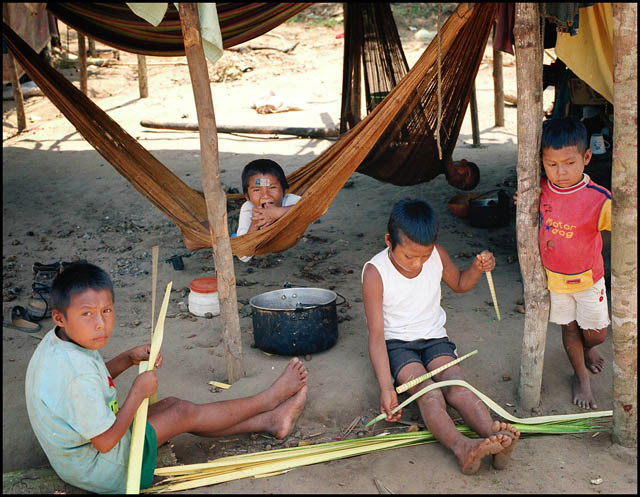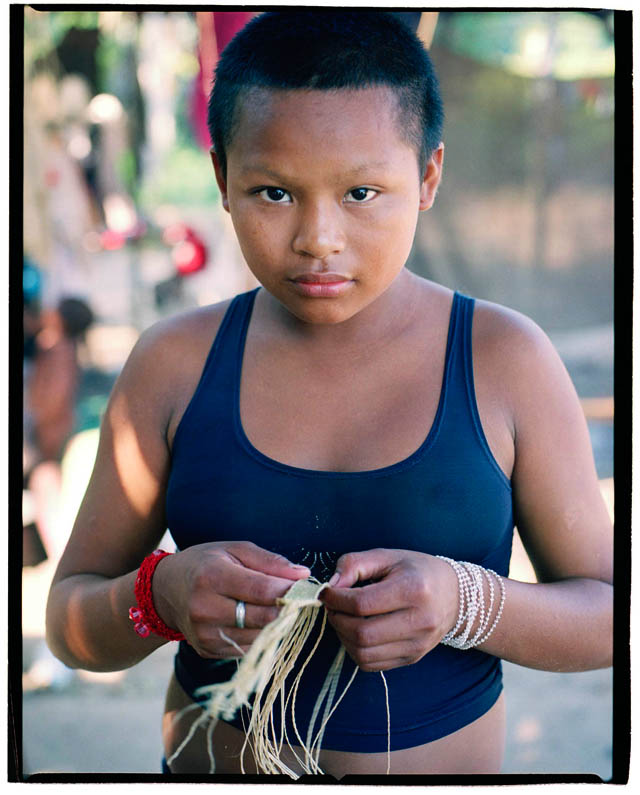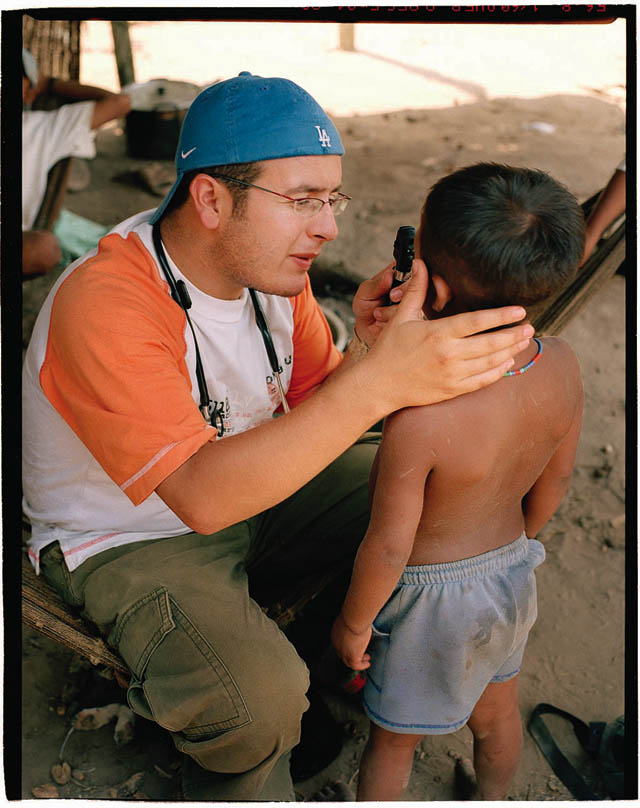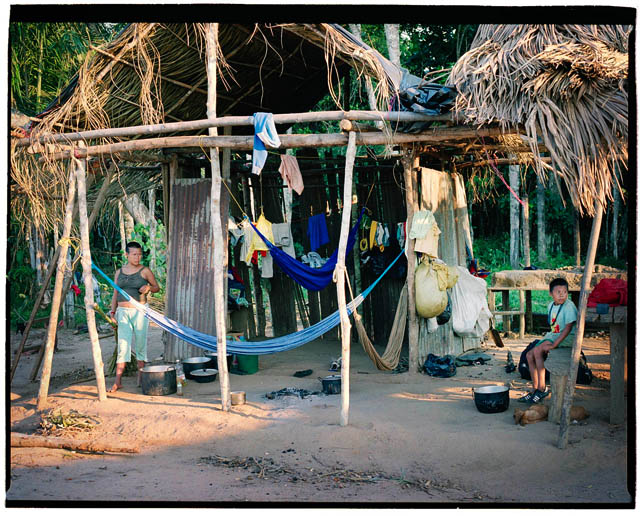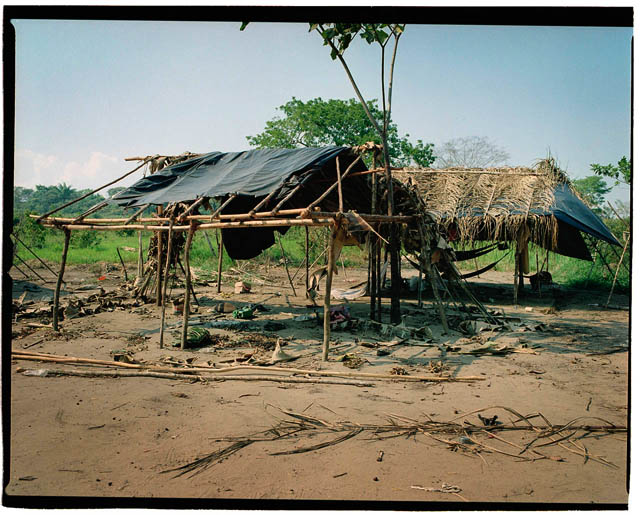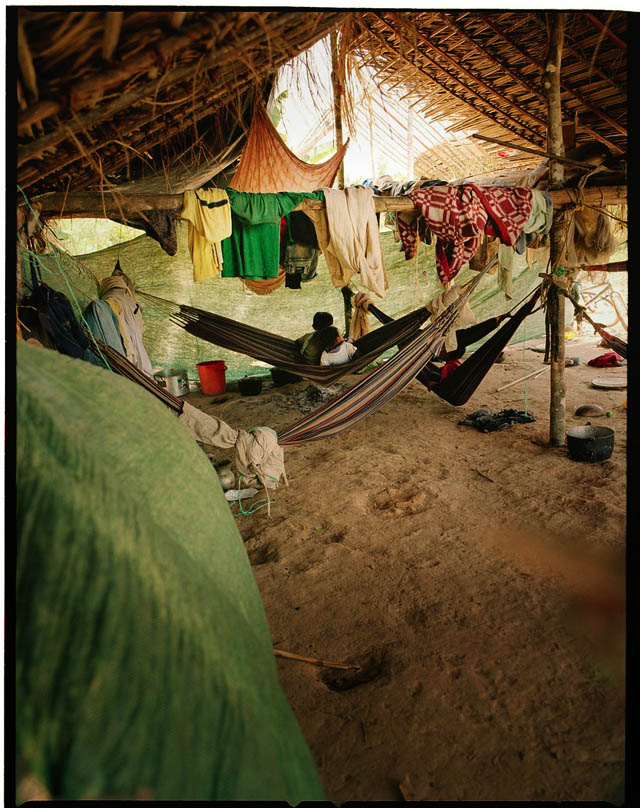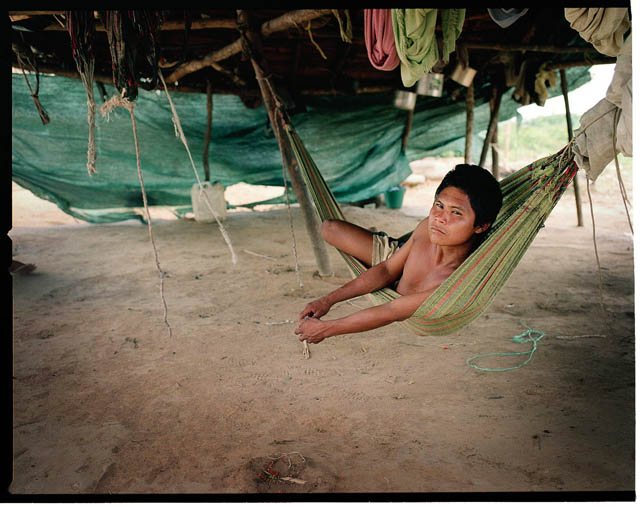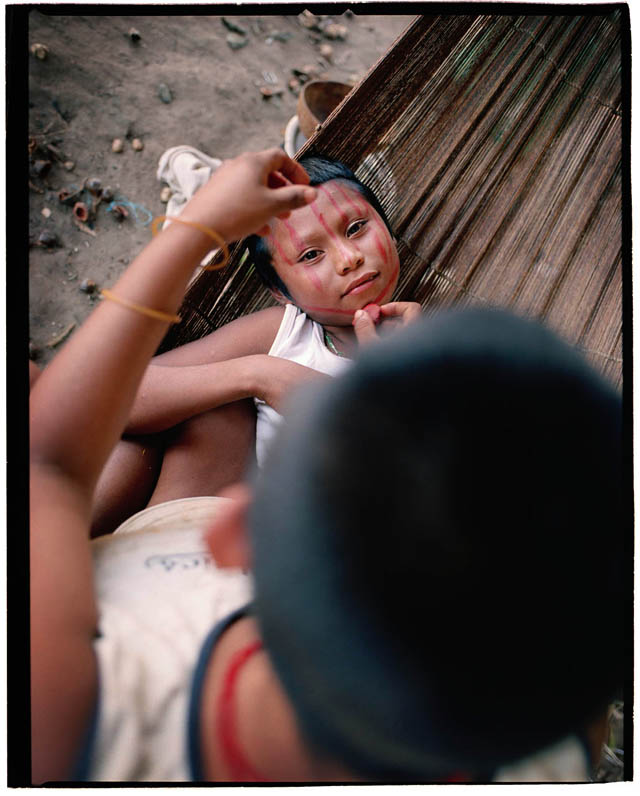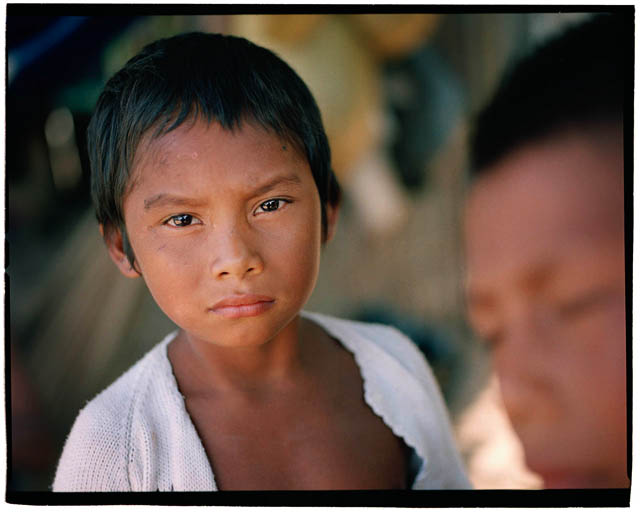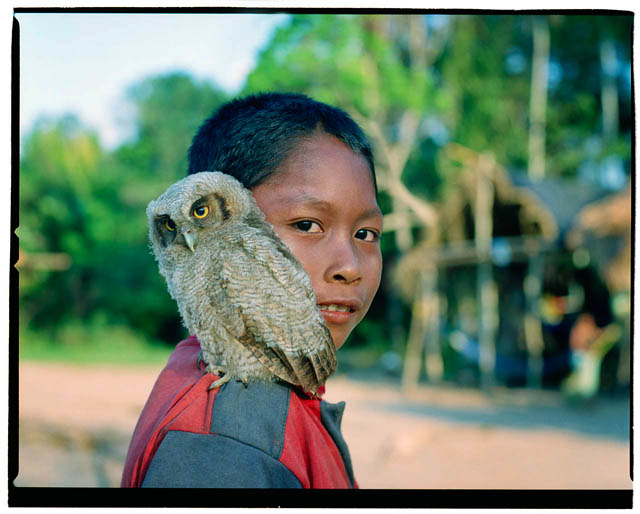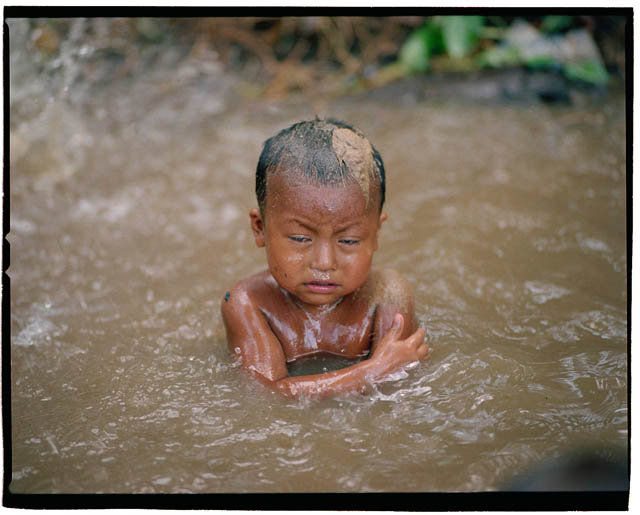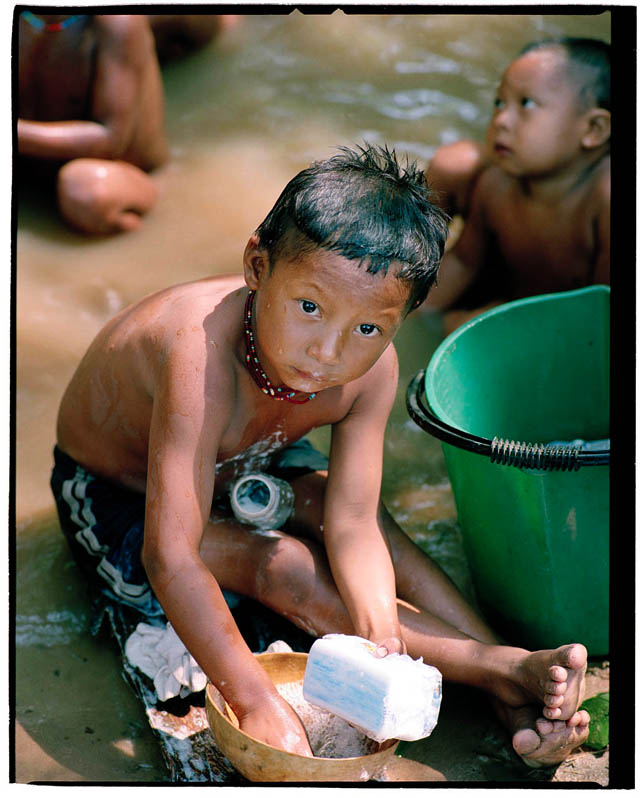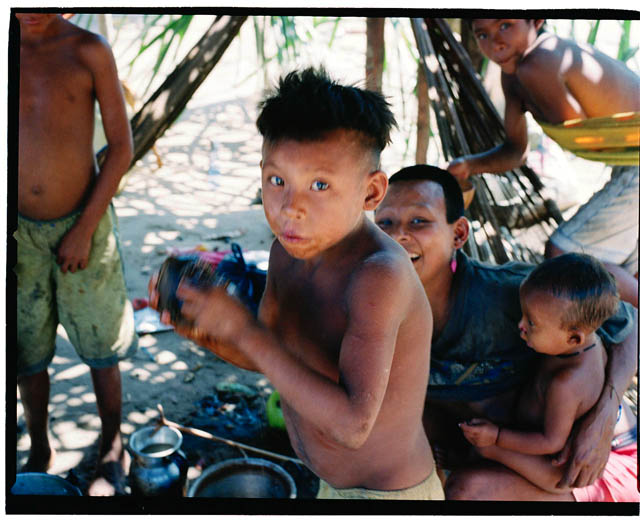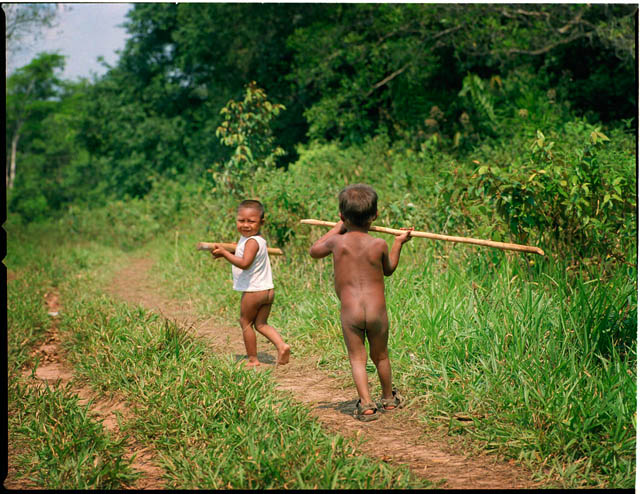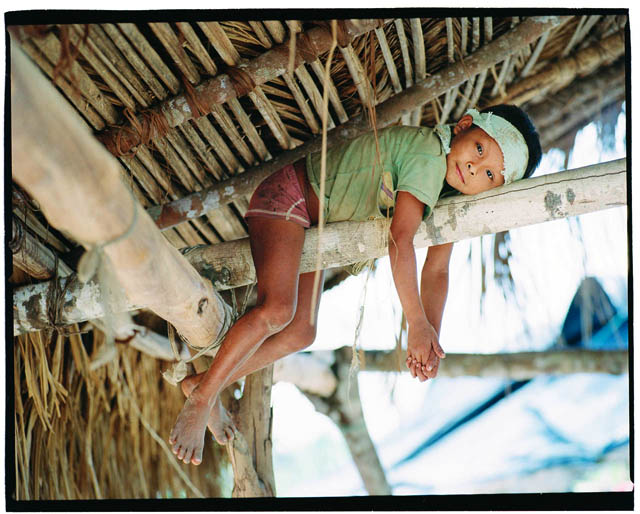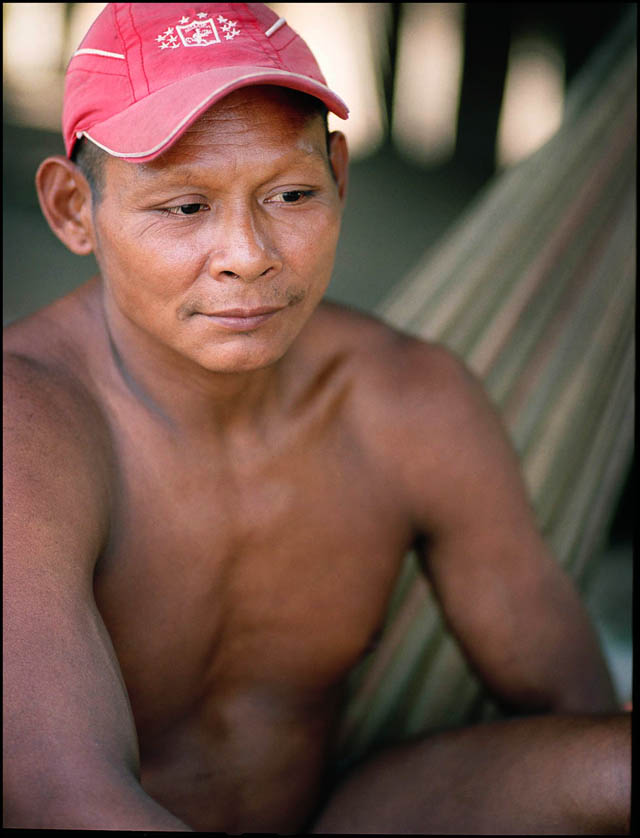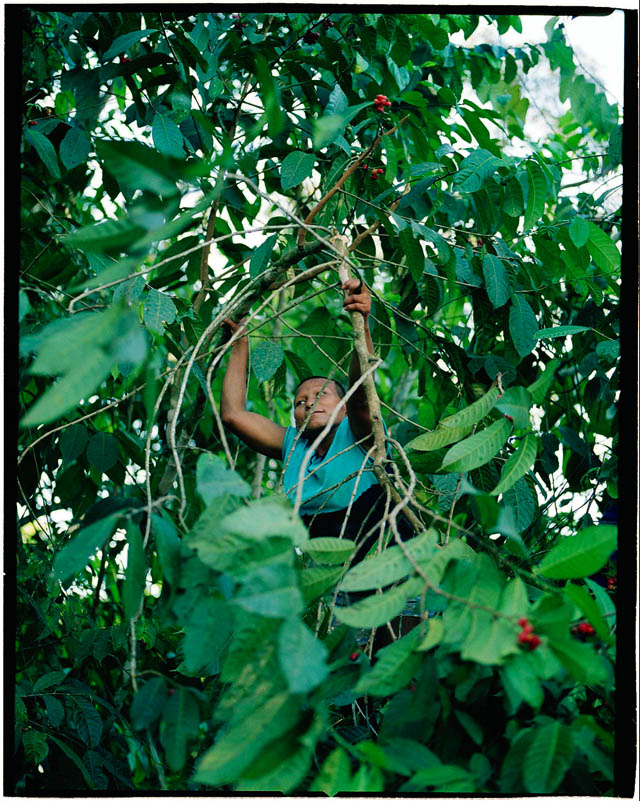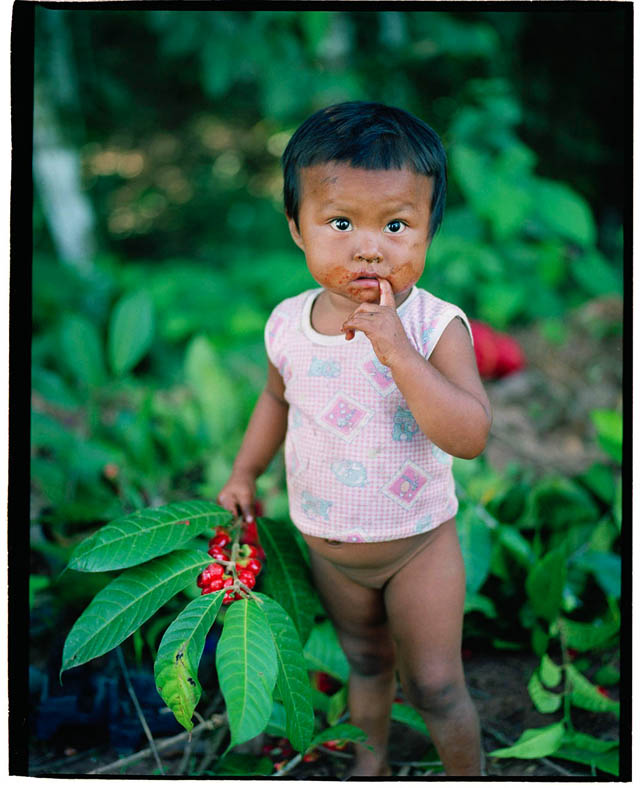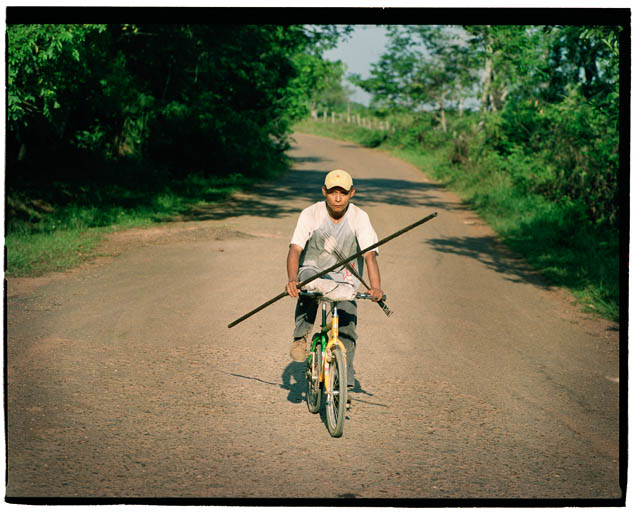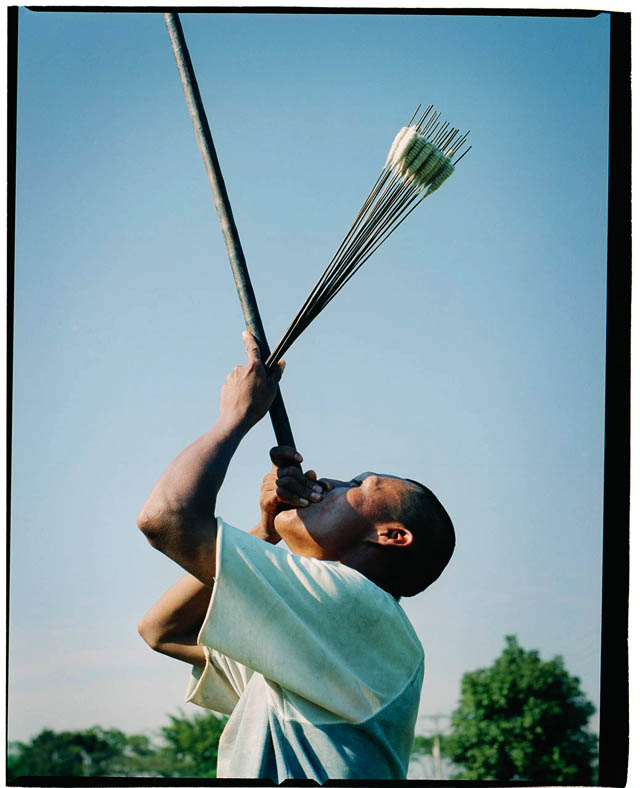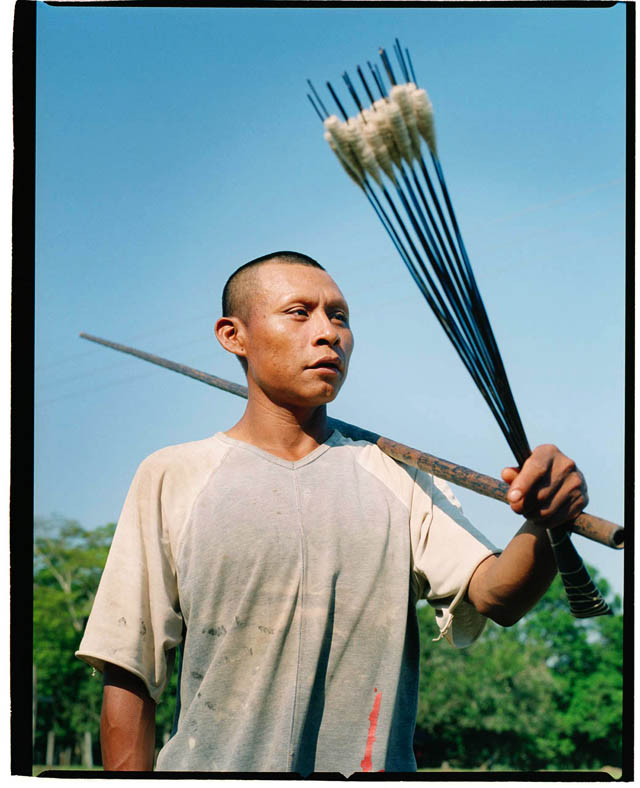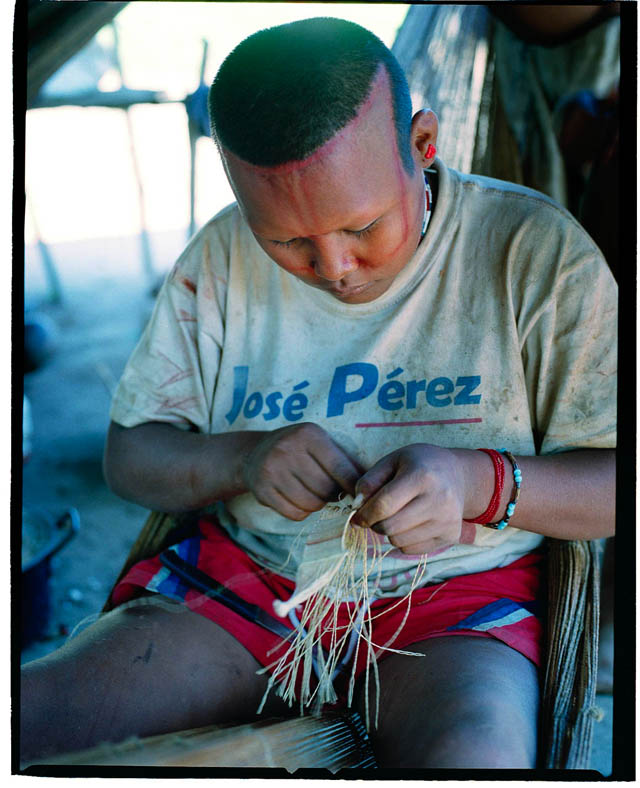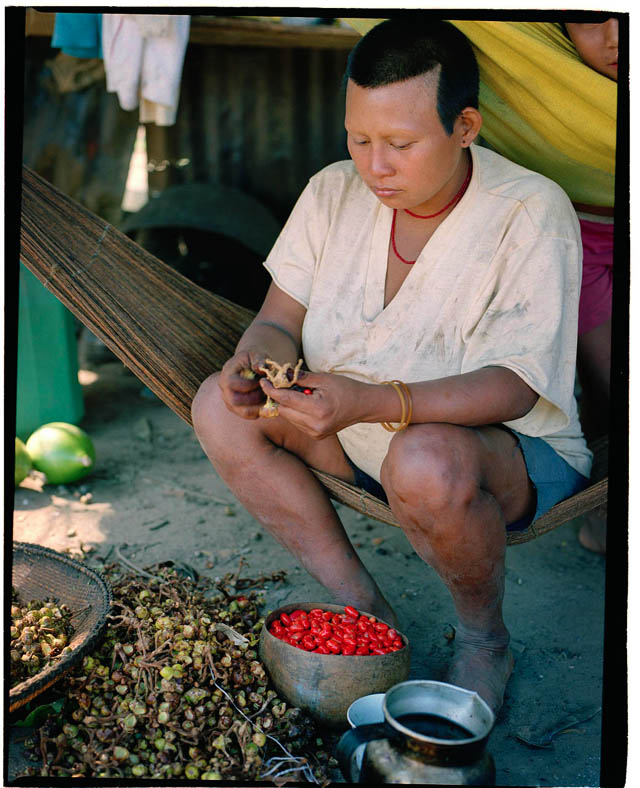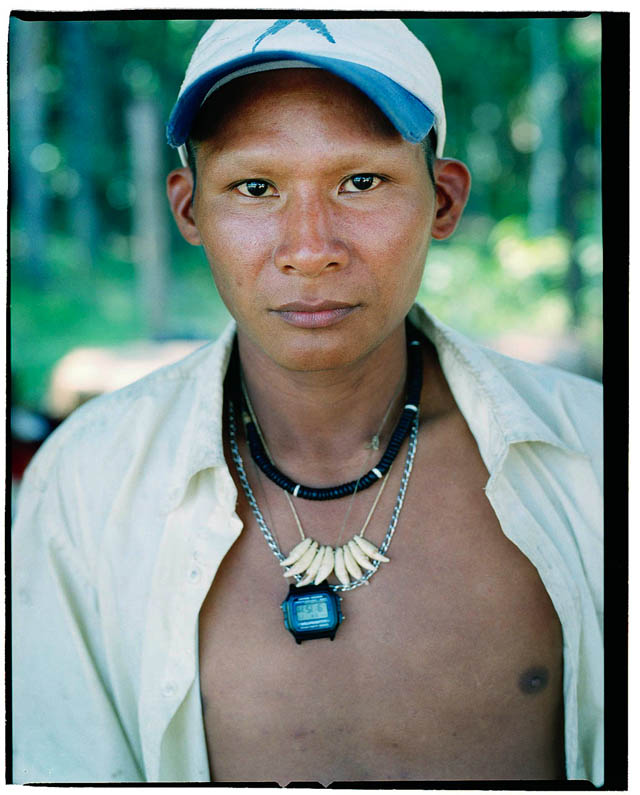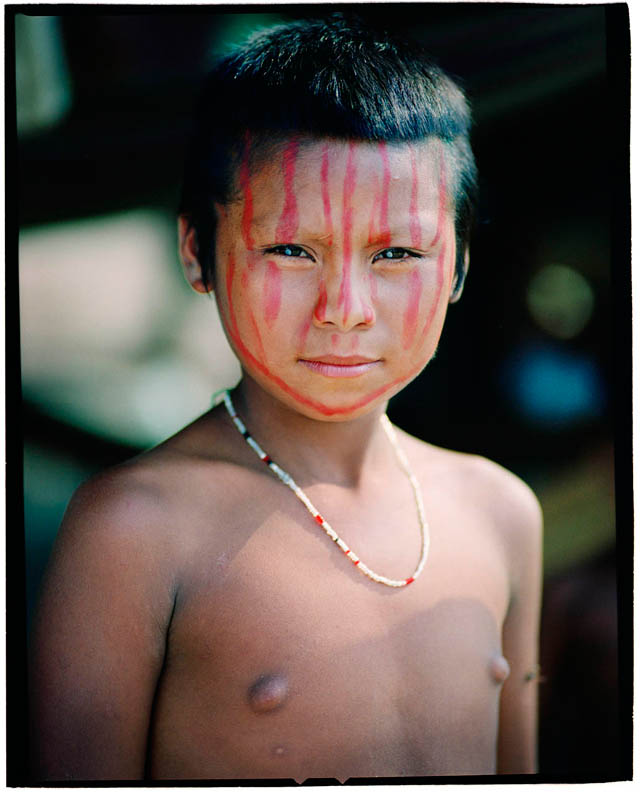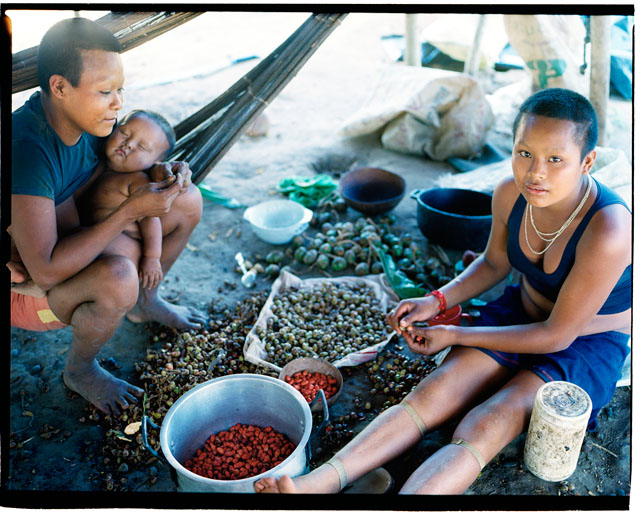|
||
|
|
|
I’d always thought time travel was impossible.
But I’m in Colombia, by far South America’s strangest country. It is the land
of Nobel Prize winning author Gabriel Garcia Marquez’s “One Hundred Years
of Solitude” and Magical
Realism, so just about anything
is possible. Forty minutes after boarding a plane in Bogotá, the nation’s
capital, it turns out I was wrong; suddenly, the clock has been turned back
five hundred years. I’ve landed in San José
de Guaviare, a town bordering on
the Amazon Basin. Twenty children’s faces are staring at me in absolute
amazement. They’ve never seen white skin, or blue eyes or anything other than
straight black hair. I stare back, equally amazed by their lack of eyebrows, their
close-cropped hair with triangular bald patches and their faces painted with red
dye, which is used along the Amazon River as mosquito repellant. They
approach cautiously, some touching my skin as though I were a precious jewel.
Awoken by the fuss,
several of the elders stir from their hammocks and come over to investigate.
The coffee and rice I offer as a show of good will are accepted graciously,
although I now realize they were unnecessary. This is a very peaceful tribe,
friendly and hospitable, even though, or maybe because, their contact with
“white man” has been extremely limited – until now. Even with the adults,
communication is difficult as few of them speak Spanish. They talk amongst
themselves in a high-pitched chatter, the entire group often laughing in
unison. When I take out my tripod, the group falls silent. The children play
with the tripod for hours afterwards and their amazement does not diminish. Until recently, a meeting
like this would have been impossible; the Nukak Maku were nomads – changing their whereabouts every
couple of days in the extensive rain forests of the Amazon basin. Currently, most
of them are located in refugee camps like the one I am visiting. I arrived
here with Doctor Javier Maldonado, a general practitioner who arrived here to
do an internship, and was so appalled by the living conditions that he
decided to do something about it. He now gives basic medical care to Nukak
Maku groups that have been arriving to this area over the last three years.
As he introduces me to the various clan members, he starts telling me their sad
story. ‘Less
than fifty years ago the first colonists arrived to this area, driven here by
violence in other parts of the country. In those times, people hunted Indians
for sport, or caught them to use as slaves. So it is not surprising that the
nomads of the Nukak Maku preferred to stay in the jungle where nobody
bothered them. And then one day, about seventeen years ago, a group of around
fifty sick and starving women and children came running into the village of
Calamar, after a journey of two hundred kilometers on foot. What had happened
to the men of this group never became clear. Naked and hungry they entered
the gardens and houses of the locals, looking for food. Being nomads, they
had no concept of private property, and communication with them was
impossible because nobody could speak their language. The locals were dead
scared of the naked ‘savages’ and sent them back into the woods as quickly as
they could. But “the evil” had happened – this brief contact with Westerners
had brought them in contact with influenza and tuberculosis. Within a few
years the majority of the Nukak Maku were dead.’ Just as I am convinced
that I am really in the sixteenth century, a noisy Black Hawk helicopter
flies low over the camp. These choppers are part of the United States’ arsenal
in the ‘War on Drugs’; they are used to protect fumigation planes spraying
coca crops. But, put quite simply, it’s not working. At least not in this region.
Here in the rainforest no other crop will grow except for bananas and
potatoes, both of which can be produced far cheaper in other parts of the
country that have better transport infrastructure. And as long as there is
demand for cocaine, there will be coca plantations to supply. A more recent
problem for the area is the discovery of underground oil reserves – an
estimated 24 billion barrels - which makes the area attractive to both the
illegal armed groups that have been waging war in the country for several decades.
These two groups – the FARC Guerilla and the AUC paramilitaries - control
just about everything that is illegal in Colombia – from massacres to
kidnapping to the cocaine trade. Javier:
‘After the first contact the Nukak Maku were world news for a couple of
days. They were the last group of Indians to come in contact with the Western
world. UNESCO put the Nukak Maku on their list of ‘human groups that need
special treatment’ because of their high vulnerability. But after that they
were largely abandoned. The government designated an area of a million
hectares as a ‘resguardo’, a reservation where they were supposed to be able
to live in peace. However this reservation appeared to be a fiction; parts of
the assigned area had already been colonized and were being used as farmland,
mainly for coca plantations. In
recent years the area has increasingly become a war zone in which the AUC and
the FARC battle over territory. They do not care about indigenous’ rights;
there have even been cases where they were captured as slaves to serve in
their army units.’
Javier:
‘At the time of their “discovery”, the Nukak Maku’s population was
estimated to be about 1500. At present, about 380 are thought to be alive, of
whom the eldest are around 40 years old. Over the last 15 years all the
elders have died, mainly from flu and killing. Of these 380 persons, over 40%
are now living in refugee camps like this one, on land with a very different
vegetation to what they are used to, making it almost impossible for them to
feed themselves. Also, it is impossible for them to move around in this area.
Usually the Nukak Maku ‘move’ every 3 to 10 days, but the first refugees
arrived here over 3 years ago and have not been able to change location once.
The piece of land they have been allocated does not have flowing water; instead
they use two nearby ponds – one for drinking, one for bathing. This is why
all children have parasite-infections. But the problem is worsening; the drinking
water pond has dried out, and the washing water basin is too dirty to be
drunk. The rainy season probably won’t start for 2 months. Even
among the extremely friendly and positive Nukak families, hunger and thirst
are starting to cause rifts; last night there was a fight, and this morning
two families left the camp, looking for a better place to live. That will not
be easy as the entire surroundings of San José de Guaviare are colonized; the
farmers do not tolerate Indians on their land, and nobody will offer them an
airplane ride back to their territory. Private
property and money are not concepts the Nukak Maku traditionally understood.
The survival of the Nukak is based on moving frequently from site to site,
using the few products the rain forest offers for survival. When they discover a tree with
berries, or a palm tree that has edible maggots in its bark, they tear it
down immediately. They leave the seeds on the ground so that when they come
back to the same site, new trees will have grown. When they arrived here they
did the same thing on farms, but to the farmers the palm trees are a status
symbol. As a consequence the farmers do not hesitate to shoot when the
Indians set foot on their lands.’ When he hears I am from
Bogotá, one of the older members of the group approaches me. He introduces
himself as Hweby. I estimate he’s
about 35 years old. In poor Spanish he asks me whether I can tell him where
his son is. He was transferred from the local hospital three months ago with
tuberculosis. They
said he would be transferred to Bogotá. Since then the family has had no news
of him. As I live in Bogotá, Hweby asks me whether I have seen him. Whether
he is doing well? Whether he is still
alive? Explaining to him that Bogotá has 11 million inhabitants is useless. His
culture does not have numbers: no ages; no distance; and no money. He can’t
relate to a society where everything is counted in quantities. General
practitioner Javier says that the only good news he can give Hweby is that
the local hospital
would have given him notice if his son had died. But even he can’t get any
more information - an indigenous child is not high priority.
Javier
continues his story. Over a year ago he teamed up with Jorge Restrepo, an
anthropologist who has had contact with clans since 1989 and has lived in the
jungle with a clan of Nukak for over a month. Together they are trying to bring
the clans’ plight to Colombia’s attention as well as to international aid
organizations. ‘This is harder than
you might expect – even the urgent installation of a manual water pump
(costing US$150) has so far been impossible. The Red Cross recognizes there is a serious problem, and said they would
send someone to evaluate the situation. Nobody ever arrived. The government’s
department of public defense sent an observer to this
very same refugee camp, where people have been living for 8 to 14 months. When
the observer asked the Nukak whether they were going to live here permanently
or whether they were planning to leave. The Nukak answered that they were
‘just passing through”. As a result, the observer concluded that they did not
qualify for
refugee status or funding as they were still nomadic. Ironically, the
Nukak Maku are not poor monetarily. Since 1996, the Colombian government has
put aside a yearly budget to help various indigenous groups, including Nukak
Maku. By now this fund is in
the order of US$200.000. However, owing to a bureaucratic technicality, they
are unable to access their share:the Nukak do not have
a leader, which means nobody can claim this money on their behalf. For a
couple of months the government has been paying various Nukak families US$150 per month to
survive on. However, as a nomadic tribe, they have no concept of money
management. They go the supermarket in the city, spend 150 dollars on food
and drinks, eat and drink all they can for 3 days, and then have nothing left for the
rest of the month.’ We
are ready to call it a day. I can go back to an air-conditioned hotel room
and a hot meal. The 20x50 meter piece of land, granted to this group of about
70, is situated 12 km from San José city. Owing to a military curfew, we have
to be back in the village before 6pm. On our way, we pass a huge infantry
army base as well as a big antinarcotics army base. That
night I discuss the Nukak Maku with Jorge Restrepo, the anthropologist who
first encountered them 17 years
ago. ‘It is not entirely
true that the Nukak Maku had their first contact with the Western world in
1988. After they arrived at the village, they were returned to the Amazon
where other groups of nomadic ‘Maku’ live. But they could not communicate
with those
tribes either; the languages were completely unrelated. Suddenly, a most
unexpected reaction came from the New Tribes Mission (NTM), a fundamentalist
US missionary organization, infamous for their aggressive methods of
conversion and banned from most Latin
American countries. The NTM appeared to have had a secret mission post in the
Nukak Maku territory for years. They had studied the language extensively and
several of their missionaries could speak it. With their help the question of
the Nukak Maku’s
origin was quickly solved, and they were returned to where they came from.
Shortly afterwards the government sent me to the mission post to study the
Nukak. It was a strange experience - flying over an endless, dense jungle,
and suddenly there was this hole,
a landing strip that the missionaries had built! Even though the New Tribe
Missionaries allowed me into their camp (under obligation), they made it
difficult. The first contact with the groups of Nukak that passed the mission
post for food and medicine
was friendly, but after that they became suspicious and even aggressive
towards me, up to the point where I was afraid they would try to kill me with
one of their poison arrows. It turned out that the missionaries had scared
the Nukak saying things like: ‘We
do not know what that man carries in his heart’. Finally, I became so
desperate that I actually wanted to leave. But they told me this was
impossible; it would be about 3 more months before the next plane would
arrive. Out of desperation I just started
following a group as they made their way out of the mission post. Within 15
minutes there was no way I would ever find my way back by myself. For a
Westerner, there is no way to find food in the rainforest, so when the Nukak
knew I was following them, they
also knew leaving me behind would be my death. I told them that I wanted to
earn my right to stay with them, that I did not want to be a burden, but as I
had absolutely no ability that was of value to them, they named me their
‘Maku’ (slave). I became the
“slave of the slaves”. Every night I had to
find wood to keep the campfires of 5 families going for the night. The nights
with the Nukak Maku were the most special experiences of my life. When they
set up camp, within 5 minutes every family builds a hut of branches and banana leaves. With a
kind of twine they get from a plant, hammocks are made which are placed in a
triangle around a fire. As the nights in the jungle are quite cold and
everybody is naked, every time the fire starts going out someone wakes up and adds more
wood. Usually someone else wakes up, tells a story, and the entire clan
bursts out laughing again. Even better are the times when they happen to meet
another clan of Nukak Maku in the jungle. Stories are told and the groups
party for days
on end.’ The
next day we travel 12 kilometers in the opposite direction, along the border
of the Guaviare River. Again we pass a huge military base, this time
belonging to the Government commandos. The army base bears the name ‘Nukak’,
and I remember Jorge
telling me that he and other anthropologists have been protesting about this
to the government for years, without success. According to International Law,
army installations are not allowed to carry names belonging to parts of the
civil population as this
can put those people in danger. So, whilst the Nukak want no part in the
Colombian armed conflict, both paramilitaries and guerilla groups now
associate their tribal name with army commandos, instead of with the peaceful
indigenous people they are. To
make matters worse, the government placed the base partially in territory
that had been assigned to a different group of displaced nomadic Indians, the
Guayaberos. They arrived here 2 years
ago with about 180 families who had been violently forced from their own territory.
Currently, the Guayaberos also have to share this area with about 80
displaced families of Nukak Maku that have nowhere else to go.
After
meeting one of the Guayabero-clans, we continue to the very first Nukak Maku
refugees, which have been away from their reservation for over 3 years, and
who have lived in the Guayabero
refugee camp since then. They
all speak good Spanish, ride bicycles, and have a wind-powered water pump.
One of the mothers even has long hair. Suddenly we hear someone cursing in
Colombian slang. ‘Holy shit, how my
feet smell! - Those fucking rubber boots!’ One of the women
calls: ‘Hey, Mauricio, want a cup of coffee?’ He answers that he does not
feel like drinking coffee but would
prefer guarapo (an indigenous
alcoholic drink made of fermented fruit, in this case pineapple). [Following
introductions,
he tells me how he fled from the hands of the FARC, who forcibly recruited
him into their army. He now works on a coca plantation in order to provide
for his clan. But the clan is expanding just a little too quickly, with over
100 people on a piece of
land not even half the size of a football field. Of course, he would prefer
to return to his tribal lands and lifestyle, but that is becoming more and
more difficult. “We
like comfort as much as you white people do. So, for example, I would like to
take at least
a metal machete with me into the
jungle. And maybe a bike,” he adds, laughing out loud. Javier: ‘With the passing of
time, of course, it will be harder and harder for the displaced indigenous
groups to return to a nomadic lifestyle. The children that were born here will have a very hard
time surviving in the jungle. Besides, they are already facing ‘Western’
problems: they hardly move, which causes many to become too fat to be able to
move swiftly through the jungle. They also eat sugar now, which causes tooth
cavities. Meanwhile they want to listen to pop songs on the transistor radio
that a friend of mine gave them. They now constantly need batteries. The
longer it takes for them to return, the slimmer the chances that they will
actually be able
to do so. Maybe they are best off if they start going to school, speak
Spanish and learn math…’ Two
days later, after a day of exploring the neighborhood and sighting grey and
pink river dolphins as well as coca plantations and cocaine processing
laboratories
near the Guayabero River, we go back to the first
camp we visited. Javier introduces me to Monicaro and his wife and
three children. Monicaro invites us to go
hunting with them. There is no more face painting, and they now keep their
western clothes
on so as not to offend the locals. Besides, they have been wearing clothes
now for almost a year and a half, and already it feels uncomfortable to walk
around naked. Also they are not as resistant to the mosquitoes as before. The
Nukak Maku live off fruits
and berries that they find in the tropical forest, they hunt monkeys and
birds, or fish when nothing else is available. Monicaro carries a long bamboo
rod, from which he can blow poisoned arrows that paralyze monkeys and birds
that are in the high foliage
of the rainforest. If they capture a mother monkey or a bird with young, they
also take the offspring to raise them in their camp, releasing them back into
the jungle when they are old enough. The
problem is that around the refugee camp area, the kind of monkey they
usually hunt hardly exists. Instead, they hunt a much smaller kind of monkey,
which has little meat. Furthermore, there are fewer and fewer monkeys, as the
Nukak overhunt the supply in their limited hunting region. It’s
an hilarious sight -
Monicaro the Nukak Indian, riding a kids’ bike on his way to the local jungle
with a bamboo hunting stick. His wife and kids follow, picking berries along
the way. Along the road there are two big dogs guarding a farm. The bike is
hidden in the woods, and
the family crosses a fence to make their way through the meadows. Because we
white people are too slow and noisy and scare the monkeys away before we even
get close, we decide to leave the family alone so they can eat that day. When
we get back to the camp,
it turns out the other family who had left owing to the previous night’s
dispute has also returned. There was nowhere they could go. Hweby, the father
of the sick boy who was sent to Bogota, has fallen ill himself. He has
visited the local hospital twice
over the past week, and they kept him waiting there all day without even
looking at him. Javier examines him, and is afraid he might have
tuberculosis. The doctor’s fear causes a weak smile on Hweby’s face. He
wonders whether, if they send him to Bogotá
as well, he might finally be reunited with his missing son. |

